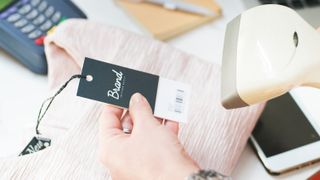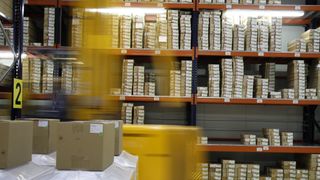Barcoding the world
How the barcode has changed retail, technology and the healthcare industries

Steve Mulron is a Data Capture Expert for the EMEA region at Zebra Technologies.
In our daily lives we hardly give the barcode a second thought. We only really come across it when we’re shopping and even then, it’s merely a ‘bunch of lines and spaces’ that helps us process the transaction and buy an item.
But the barcode is so much more than that. The barcode powers everything from shopping to dining out, to healthcare and even logistics. It is estimated that it is used on more than a trillion possible products worldwide and this number will only increase as more products and services are being created.
While this might sound like an over exaggeration, it is not. The barcode, from its humble beginnings, has become one of the most essential tools of modern life. The famous song lyric tells us that, “money makes the world go round,” but in our current, always-on and connected world, it is in fact the barcode.
- Why paying with your palm could be the new way to shop
- Zebra Technologies boosts rugged device unit with Xplore acquisition
- HP and PayPal team up for new SMB POS system
FMCB - Fast Moving Consumer Barcodes
The barcode was invented in 1952 by Norman Joseph Woodland and Bernard Silver and was inspired by Morse code. Its first use was on American railroads in the 1960s and involved placing colored stripes in various combinations on steel plates fixed to the sides of railroad stock. It wasn’t until an additional decade of adaptation that the barcode was trialed in a Kroger U.S. grocery store, opening the door for the barcode’s inclusion in everyday life.
Since then, the barcode has taken over retail and transformed how we shop. It still does the job it did back then, being affixed to products and making it easy for cashiers to process items for customers. Today, it is even more efficient. Cashiers can still use multi-plane, fixed grocery scanners to read barcodes, and store clerks can also be more mobile and offer scanning facilities throughout the store with handheld scanning devices.
Schnucks, one of the largest privately held, family-owned US supermarket chains, is doing this and more. It is transitioning from the traditional 1D barcode made up of lines and spaces and moving to 2D barcodes – made up of many small, individual dots in square shapes and scanners to embed additional data to ensure accurate data capture while enhancing store productivity and efficiency. As part of this shift, Schnucks is deploying Zebra data capture, mobile computing and printing solutions to increase store associate productivity and improve the customer experience.
Schnucks is utilizing Zebra’s MP7000 multi-plane 1D/2D imager and DS8178 cordless scanners to reduce double-scans and improve checkout speeds. The MP7000 can capture virtually every electronic and printed barcode in any condition, as well as GS1 Stacked DataBar barcodes for fresh products. The retailer also uses the Zebra QLn320 mobile printer for printing shelf labels consistently that can be scanned across all stores.
Are you a pro? Subscribe to our newsletter
Sign up to the TechRadar Pro newsletter to get all the top news, opinion, features and guidance your business needs to succeed!
New barcodes, produced by U.S. company Digimarc, cover the entire packaging of the product, making the struggle to scan an item a thing of the past. The company has already implemented its innovative new scanning technology in two American stores. Developing this further, Digimarc scannable packaging will save time during checkout.
However, it doesn’t stop there. Retail establishments of all sorts are now working on even more innovative ways to make shopping more efficient and effective for store assistants and more enjoyable for customers. In doing so, customers are now given the ability to use their own mobile devices or handheld scanners to peruse the store at their own leisure and “shop as they go”.
This personal shopping capability allows customers to scan barcodes independently and also tracks their in-store location, offering them discounts based on previous purchases, directing them to their favorite items and even alerting them of potential harmful allergy risks in certain items. In the future, barcodes could be completely removed from shelves and instead replaced by ‘scannable’ packaging.

From store to warehouse
The barcode is also having a profound impact on how food and other items are transported worldwide, beyond how the items are purchased in store.
Of course, the logistical journey starts in the warehouse. By using barcode-enabled technology such as handheld and wearable scanners, warehouse staff can pick, pack, locate, maneuver, store and ship items more efficiently and effectively. It’s not just about the hardware, though. Software is crucial to make warehouse management more agile. What is needed is a solution that complements the hardware to ensure all collected data is actioned properly. For example, Zebra’s Mobility DNA and Link-OS pairs with Zebra’s TC52 and TC57 mobile computers as well as WT6000 wearable computers to create one seamless solution that oversees the entire warehouse operation.
But, just as the product leaves the warehouse, so too does a manufacturer’s influence. Field operatives on the road must still deliver the best service, and to do so they need tools that can give them visibility across field associates, customers, goods and assets. Without this insight, any gains seen within an organization’s four walls are immediately lost. Therefore, on the road proof of delivery, collection and fleet management are crucial to maintaining these high standards.
Similar warehouse handheld devices and more rugged ones such as Zebra’s TC72 and TC77 mobile computers, enable road operatives to track delivery and collection. These devices can also be used by drivers to communicate back to base, responding to all enquires and providing regular updates.
Reynolds, one of the UK’s key food distributors, relies on Zebra to provide popular restaurants like Pizza Express, Carluccio’s and Byron with produce from its nationwide distribution center in Hertfordshire.

The best in health bar none
In hospitals and the pharmaceutical sector, the barcode is enhancing processes.
Even today, many healthcare systems still rely on handwritten documents which can lead to mistakes stemming from illegible handwriting and fading ink. This is where the barcode brings multiple benefits.
Instead of using paper and pen to manually document treatment, barcodes and scanners can be implemented along with a patient identity management solution to accurately and quickly match patients to their records, medication and treatments. This ensures mistakes are kept to a minimum, while patients receive the right care.
Such benefits can also be seen across an entire healthcare facility. To ensure care teams can communicate and work together to assist multiple patients, institutions are adopting healthcare mobility solutions. These solutions enable hospital staff to reliably communicate with each other and quickly and securely provide critical medical information. Patient data can also be collected and shared in real-time, providing access to patient vitals, diagnoses, imaging and much, much more. This all equates to workflow efficiency improvements and a reduction in false alarms, notifications and most importantly, fatalities.
Finally, the barcode is being used to monitor the health of the institution itself. From physical assets like an MRI machine to the staff, it can help enhance real-time data sharing and analytics, making the facility even more efficient and effective.
According to the World Health Organization, about 700,000 deaths worldwide every year are caused by the sale of counterfeit medicines. No country is immune from this scourge, with traffickers primarily targeting anti-cancer drugs which can carry an annual treatment cost of more than $50,000.
Thanks to a unique identification code, specific to each unit being sold, the origin and composition of a product could easily be ascertained. Using a basic 2D barcode flash, distributors would be able to follow their listed products in real time anywhere in the world. In the example of a bacterial contamination, distributors could react quickly to prevent it from reaching consumers.

Track and trace
The barcode is also playing a crucial role across industry in tracking and tracing items by knowing the location of any item in the world. This is something many industries need now.
To help fight the continuing rise in counterfeiting and counteract the illicit tobacco trade, the European Union (alongside other independent states) has ratified the Tobacco Products Directive, which will enforce new obligations throughout the entire tobacco supply chain, significantly changing how it currently operates. From 19th May 2019, by law everyone involved in the manufacture and distribution of tobacco products must implement new measures such as security features and traceability systems that will help to achieve compliance across their supply chains.
In the healthcare sector, more than 400,000 pharmacies in Europe will be impacted by the new European Directive entitled the Falsified Medicines Directive to outlaw fake and illegal medication floating through the supply chain.
It is estimated that one percent of medicines sold to the EU public through the legal supply chain are fake. Under the Directive, safety features will need to be placed on individual packs so that they can be identified, and authenticity is guaranteed. These will also allow pharmacists to check if the outer packaging has been tampered with.
The intent of this measure is to prevent the introduction of illegal medicine into the legal supply chain. This means pharmaceutical industry players must consolidate their medicine traceability practices to fight a rise in counterfeiting.
Thanks to a unique identification code, specific to each unit, the origin and composition of a product could easily be ascertained. Using a basic 2D barcode flash, distributors would be able to follow their listed products in real time anywhere in the world.
The barcode has come a long way since its humble beginnings on the railroad, transforming not just the retail sector but practically every industry that we rely on today. And, with more products and services being launched every day, it is clear the barcode will continue its crucial role to track and monitor, becoming even more indispensable.
As for the future, the barcode is here to stay. Its journey is not even a decade old and we have seen such innovative and life-saving developments that its value will only increase, being critical to the success of global industries and re-writing the future in lines, small squares, radio frequencies and much more.
Steve Mulron, EMEA Data Capture Expert at Zebra Technologies
- We've also highlighted the best scanning software
Most Popular




